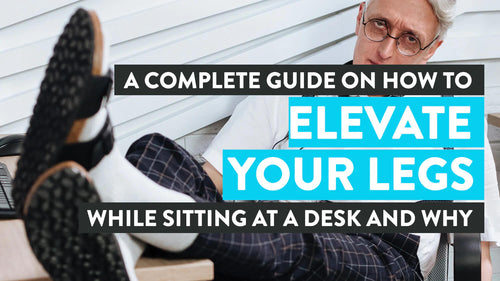
News
Are Standing Desks Better For Your Health?
Hayden AdamsOver recent years, it feels like there has been a revolution in the understanding of public health, with the focus falling largely on the health effects of our increasingly sedentary lifestyles. Numerous studies have confirmed that extended periods spent sitting are contributing to a staggering range of serious health problems. Obesity, heart disease, high blood pressure, stroke, type 2 diabetes, and even some cancers have been linked. And that is before we even start on more minor problems like strain injuries, back pain and postural issues.
Even if these seem relatively minor in comparison, for the sufferer they can feel very serious indeed. What’s more, they are a major contributing factor in workplace absenteeism, which in turn means they have serious economic effects for the individual, the employer, and the economy as a whole. For all of these reasons, sitting is now considered to be as harmful to public health as smoking.
Believe it or not, one study into this area found worrying trends as long ago as 1961. Research conducted in the UK found that bus drivers were three times more likely to suffer “sudden death” than conductors, who spent all day on their feet. This study made the first links between a sedentary lifestyle and heart disease. It also found that standing was potentially the answer. However, it wasn’t after the turn of the millennium that doctors began to revisit this area, at which point studies emerged all over the world confirming what we already knew: sedentary lifestyles are killing us.
The WHO now lists sedentary behaviour as one of the top ten causes of death worldwide, and there is little doubt in the medical community of the risks. However, what is less clear is what we, as individuals, can do to help ourselves. Of course, increasing your physical activity will help. But finding the time in our busy lifestyles isn't always easy. And with so much of work now office or computer-based, more and more of us are at risk.
That’s why research into sit stand desks has continued at pace ever since they hit the market. With the reality being that many of us will remain stuck at our desks for the foreseeable future, the hope has always been that sit stand desks can help us change our behaviour and embrace a more active work life. But can a desk really improve your health?

Can Sit Stand Desks Prevent Obesity and Heart Disease?
So do standing desks improve health noticeably? Unfortunately, the outcomes of many studies are unclear. Although there is a body of evidence that standing desks can help with back pain and in the fight against obesity, the small sample sizes and short time scale of the research conducted so far has struggled to find conclusive links that they can offset more serious problems. This was summarised in the Cochrane review of 2016, which sought to compile and analyse the data from 34 studies to find meaningful trends.
However, the study found compelling evidence that installing a sit stand desk increased standing time, and thus decreased sitting time in the work setting. Although there were definitely no adverse effects on health, the quality of evidence available and the sample size made drawing any real conclusions about the long term health benefits impossible.
A further review by The University Of Pittsburgh arrived at a similar conclusion. Although many studies had been carried out, the fact that nearly all participants were young and healthy made it impossible to draw conclusions, as problems such as heart disease disproportionately affect older workers.
And there are studies beginning to emerge which do seek to address these issues directly. An economic evaluation carried out by Deakin University perhaps carries the most promise. This study found that standing desks could have huge benefits if they were rolled out to 20% of the Australian workforce. The study also suggested that adopting this policy would reduce absenteeism, boost productivity, and in the long term save billions of dollars in healthcare.
And whether the benefits are proven conclusively or not, it appears that many key figures in business are not willing to wait for medical advice. Tim Cook of Apple personally revealed that all workers at the company’s new California headquarters had been given standing desks, describing sitting as “the new cancer”.
With larger and more comprehensive studies underway, it appears to an extent the jury is still out on the long term benefits of standing desks. However, the more recent results and studies, as well as the actions of business leaders, suggest that the standing desk will have real benefits in the fight against obesity and related illnesses.
What is not in doubt is that a more active lifestyle leads to less of these health issues. And the standing desk has been proven to make employees more active, with results showing that on average workers stood for an extra hour than they would have at a normal desk.
So even though the research into the long term effects is as yet inconclusive, all of the signs suggest that standing desks could be invaluable in the fight against obesity, heart disease and related health problems.
Is It Bad To Stand At Your Desk All Day?
The consensus is that, yes it would be a bad idea to stand and work at your desk all day long. This would be especially true if you’re transitioning from having been sat down all day previously. What is not in doubt is that you will benefit from spending at least part of your day standing. This helps keep the metabolism working, promotes blood flow, and relieves the strain on the muscle groups and joints that especially suffer from sitting all day. Keeping as active as possible, and changing your position often, seems to be the best way of both keeping active and sharing the load across muscle groups and joints. Not to mention the back.
However, there is little evidence that standing alone helps to burn calories, so using a balance board or anti-fatigue mat can help you keep moving, as well as alleviating any discomfort you might feel from extended periods of time standing. On the more extreme end of the scale, some people even work from a treadmill, so they can keep moving as they work. Making sure your workstation is ergonomically correct when sitting will help too!
{{ spec_ball_mat }}How Long Should You Stand At A Standing Desk?
Again, the jury is out on this one. Conventional wisdom had suggested that it was best to stand roughly 20 mins of every hour, or a sitting to standing ratio of roughly 3: 1. However, in this article published by The University of Waterloo, it is suggested that the reverse is true!
The likelihood is that, although there are guidelines to help, how long exactly you need to spend standing probably depends on you. We’ll all have a slightly different experience, so it’s worth remaining aware of how you feel while using your standing desk and planning your own schedule. But even then, you might not need to be so precise. If you have frequent backaches for example, you may find it useful to stand when you can feel pain to relieve the pressure.
For those adjusting to their standing desk, it is important that you phase it in at first. The reason for this is that your body is used to sitting all day, so asking it to switch to standing even a third of the time could create more problems that it solves. So for the first week, try 5 mins out of every half hour. The next week, 5 of every 25, and then 5 of every 20. Week 4, do 10 mins out of 30, then 10 out of 25, and finally 10 minutes of every 20. This will allow you to adjust, but as importantly, along the way you will probably find the right balance for you. To help get your setup exactly right, check out our guide on how to use a height adjustable desk properly.
{{ spec_dual_softwood_desk }}Are Standing Desks Worth It?
Although there is yet to be any clear evidence on the long term health benefits of the standing desk, this is simply because we haven’t been using sit-stand desks for long enough to know. However, numerous studies have indicated that the potential for these desks to improve public health is huge.
What we do know for sure is that our sedentary lifestyles are having a profound effect on our health and wellbeing. So anything we can do to cut down our sitting time and increase the hours a day we are active is a huge positive. And encouraging an active work life by installing standing desks has been shown to work.
Most of us spend over half of our waking lives at work, Monday to Friday at least. So changing our work style seems an obvious place to start to improve our health overall. For anyone concerned with their productivity, and their long term wellbeing, standing desks are well worth it.





